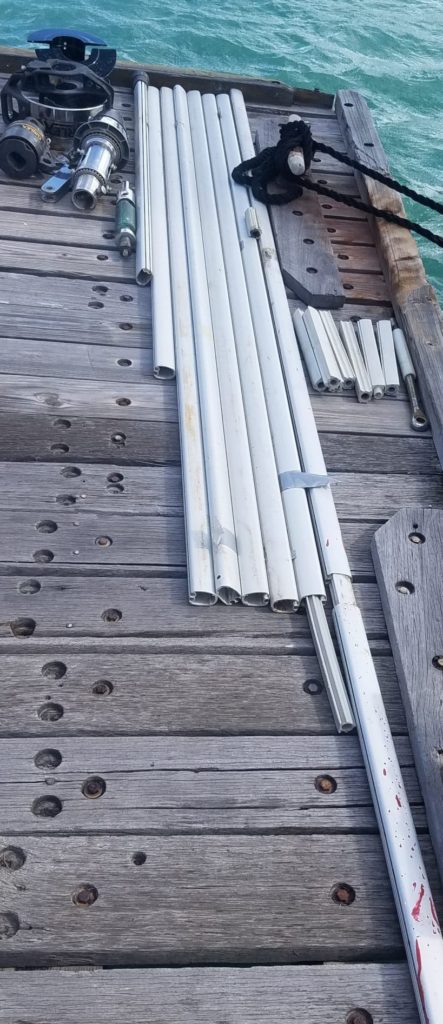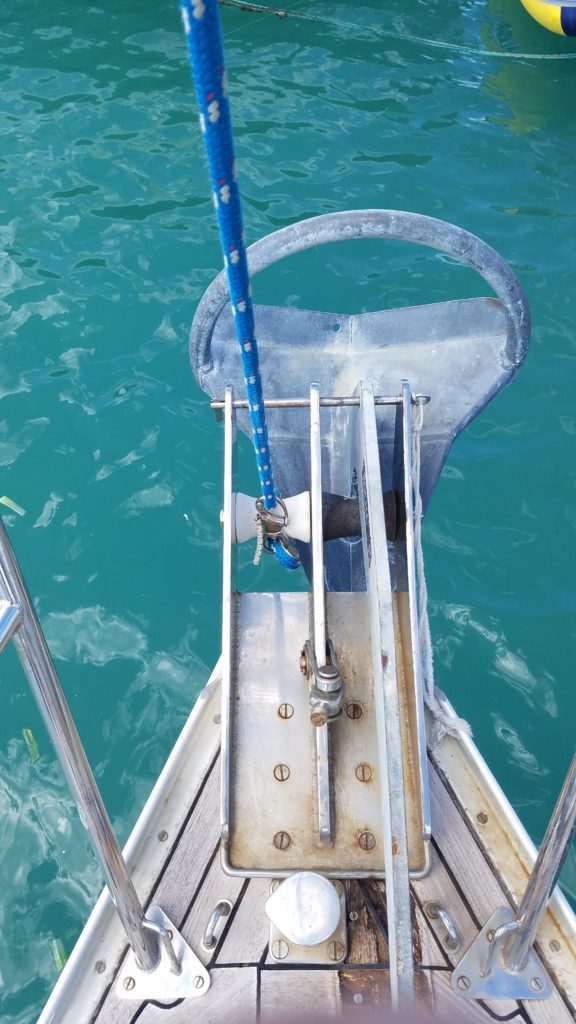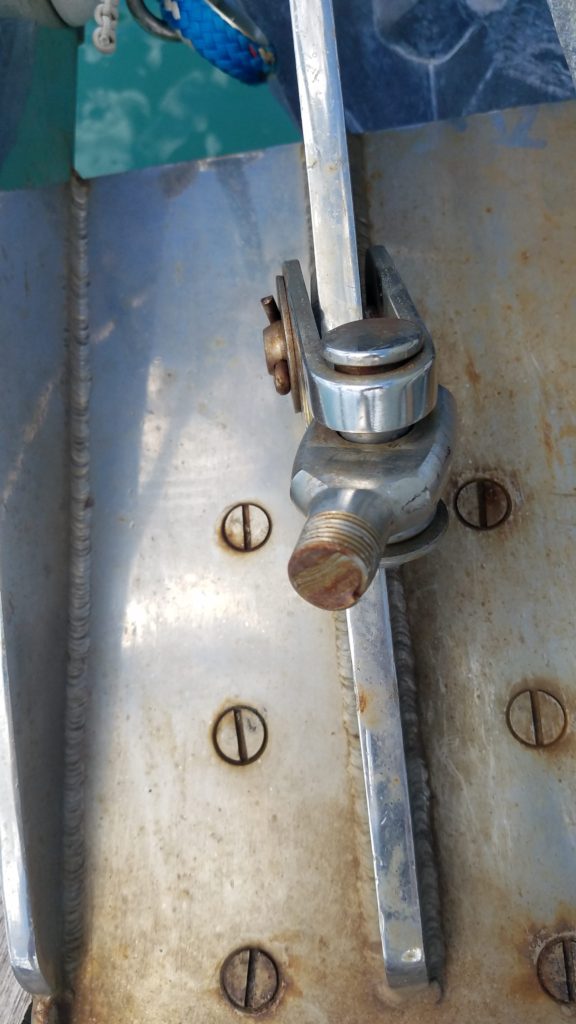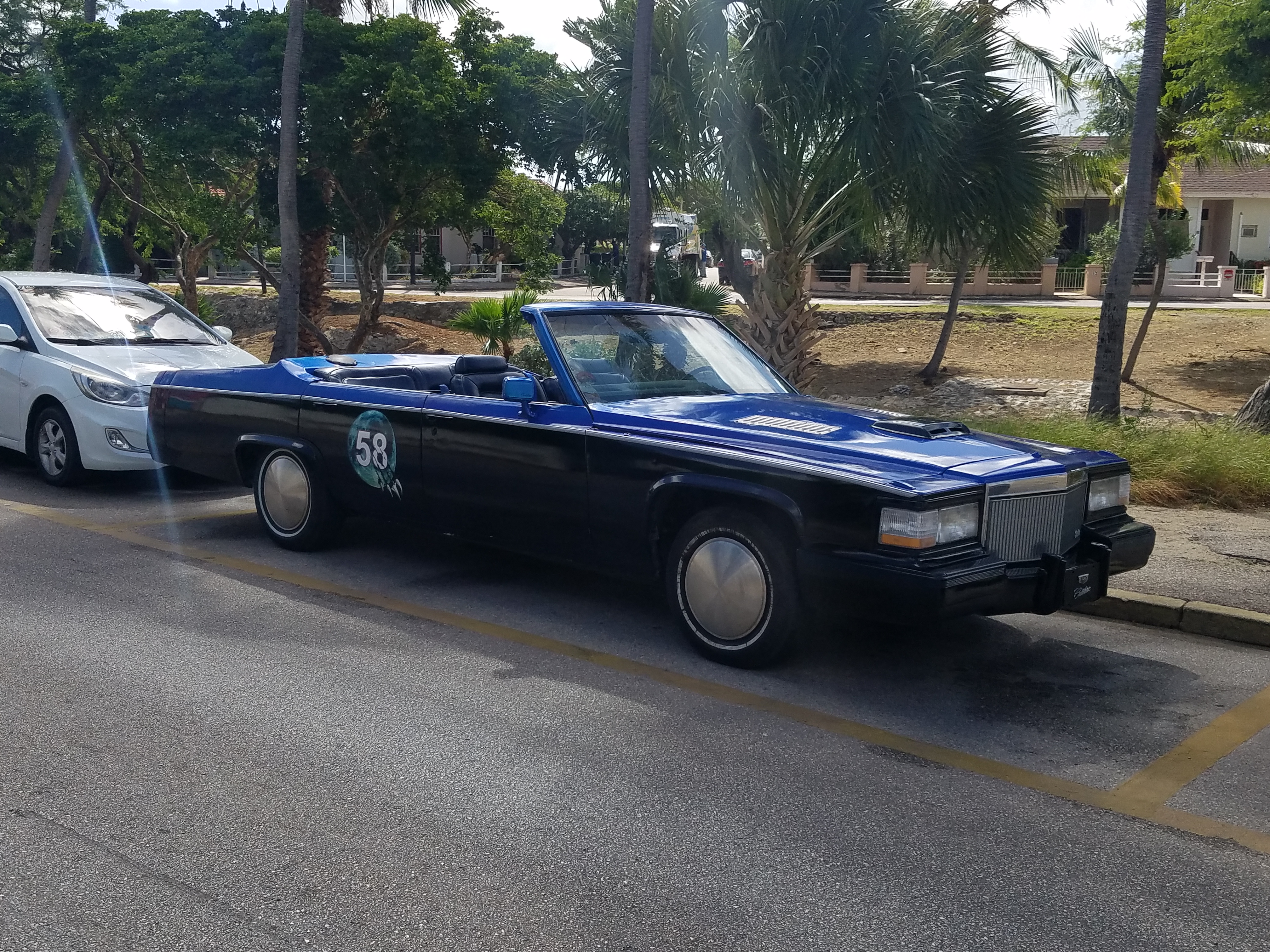Renaissance Marina, Aruba, 20-Jan-2022 – The parts were in Miami last we heard. From there they should have gone onto a ship and then come to Aruba. Directly? We don’t know. How many stops along the way? We don’t know. How long might the parts sit in customs? We don’t know.
I’m on an Oyster 485-03: a 48.5 ft British-made boat, built in 1993 in Wroxham, Norwich, Norfolk, UK.*
Some background: The owner of the boat is James Evenson who I have known virtually for five years and in person the last two years. After the literal breakup of the catamaran Zingaro, James with the help of his Patreons and through a Kickstarter campaign purchased this boat in Curaçao.
About Oysters: This short story will tell you much of what you need to know. Jennifer, Hilary and I were at the dock in Hoona, outside of Glacier Bay when the word swept around the marina like wildfire that someone would be arriving in an Oyster. The dock was literally lined with sailors waiting to see this boat. To non-sailors, there isn’t anything too exciting about Oysters. They are very well made and very well fitted out. Those who buy them new pay a lot of money – this is not a boat for the middle class – and they hold their value well.
So how was James able to afford this boat?
First, the owner had died and the family wanted to sell off the boat, so they weren’t too pushed to get top dollar.
Second, sitting in a boatyard in the Caribbean is much more punishing to a boat than in the Pacific Northwest. In the PNW, a fibreglass boat can sit for years without noticeable damage (provided water is kept out) other than fibreglass oxidation and canvas deteriorating. In the tropics, anything rubber or plastic hardens and loses its seal. All chemical reactions, like rust or other corrosion, are sped up.
Five years in a boatyard leads to so many hidden problems that they can’t be cataloged, which brings us to waiting for parts in Aruba.
The major goals of the crew on a sailboat are to keep the water on the outside and the rig (masts and sails) up. Ignoring hitting something and having a hole punched through the hull, water will come in through a fitting that is designed to let a controlled amount of water in (engine cooling water, washing water, water for the toilet, etc) or to let water out (the cooling water, sink drains, and toilet water when offshore). These are called through-hulls. Having one fail can be fatal, but generally is just exciting. However, most boats also have other fittings that pierce the hull that we don’t often think about: sensors from Sonar, speed-through-the-water sensor, old-style depth-sounding sensors, and the seal through which the propeller exits. These are oftentimes plastic and are rarely examined because their use does not require accessing them. James replaced every typical through-hull on the vessel: expensive and messy.
You know where this is going. On the first long sail, the plastic through-hull for the speed sensor failed, quickly filling the boat, damaging the veneer floors, and requiring coast guard assistance. It makes for great video.
Three months to get the boat ready turns into a year and more. The videos made in this time are great: good in production values and general interest, fantastic for learning about repairing a vessel on which everything will go wrong: All the seals need to be replaced, expected. Fittings for closing the windows on the front of the cabin fail because they are aluminum and plastic, unexpected. Wiring fails – should have been expected. The list is too long and too depressing, but must be gotten through.
What parts are we waiting for? I’m getting there.
What was the second thing the crew wants? To keep the rig up.
Modern rigs are made of aluminum masts generally (some are carbon fibre or wood). The stays to support the mast are stainless steel (sometimes UHMD polymers like dyneema), and generally have stainless steel fittings as attachment points and for tightening: Turnbuckles in American parlance, bottle screws if you’re speaking the Queen’s English in the UK or the (former?) Commonwealth.

Stainless steel is an interesting metal. Chromium migrates to the surface to keep the metal ‘‘stainless’’ – rust free. But unexpectedly, at least to me, it needs access to oxygen to resist corrosion. So, as I understand it, if a small stress fracture gets a hold – I don’t know how this starts— the fracture will grow via corrosion into the fitting because there is no oxygen. This is not like other steels where the corrosion will cause a very visible V-shaped incursion.
With a kit that includes some dyes that glow under UV light, one can search for these micro-fractures as well as with a magnifying glass. Will you find them all? Maybe. Probably, if you are diligent. Is it something that is typically done other than when looking at replacing the rigging? No.
Is this what failed? Yep. It also makes for great video, once it is posted.
This vessel is cutter-rigged, meaning it has two forward fore-and-aft sails. These are staysails, meaning they are attached to a stay (a wire) that supports the sail and also supports the mast. Sloops, oftentimes, only have one forestay.
Offshore, with a novice crew, the screw fitting that attaches the forward forestay** to the deck failed under full sail.


An aside: One of the reasons I like my small (31-foot) Caro Babbo is that one can ‘‘muscle’’ everything because it is a small boat. At 48 feet, this is a whole different kettle of fish. I’ll let you visualize a very large cable with a roller-fulling device and a big sail flailing unexpectedly – yes, I suppose they rarely flail expectedly.
James and a recent military vet wrestled the sail and fittings to the deck. The second forward stay held up the mast.

James acquired a new jib,† which is currently folded on the cabin top. We are waiting for the new forestay and roller reefing gear.
There are worse places to be stuck.
Aruba is feeling the pandemic like any place that is largely, if not wholly dependent on tourism. There are many shuttered businesses. Right now, what looks like an empty cruise ship has been sitting at the dock for two days. It has dropped its anchor, something I have never seen a ship do at a dock. (For maintenance most likely.) Other cruise ships have been coming and going with the schedule that these ships have: they arrive in the early morning and leave in the early evening. I guess nightlife is reserved for onboard the ship.

The people here live up to the friendliness I have been told to expect. Even the young men hanging around a street corner looking like gang bangers and suitably tatted up gave me patient directions to a grocery store and wished me a good day.
James figures two days, once the parts arrive on the dock, and we’ll be on our way.
I told Aruba that I would leave by the 23rd, but I don’t think they care that much.
I’ll be posting fairly regularly on this trip. I’ll post the link to our location once I have the Iridium set up.
It will be a fun trip in a place where people intentionally dive into the water. Imagine that.
* Clive, a member of the Zingaro virtual saloon, explained why these names need to be qualified so well. Apparently, the names are not unique and must be qualified to this degree. Look up towns called Hudson in North America to see that the problem is not unique to the UK.
The saloon is limited to Patreon members of Zingaro. Contribute as little as you wish to become a member. The conversations are fun, generally smart, and cover sailing and most non-political rabbit holes. There is a zoom call weekly with sailors from the US, Europe, the Middle East, and NZ and Australia. It’s a nice time. (Does the UK consider itself part of Europe? If not, add the UK to the list.)
† Interestingly, the first, most forward sail is called the jib sail; the second sail is called the staysail
** This forward stay might also be called a headstay since it is attached to the head of the mast. Things on boats often have multiple, equally correct names.


What a run of bad luck for him! Hopefully this is it. I share your view about our smaller boats. I also love that we can muscle it if things go sideways on our boat. Have a great passage! I’ll be following it closely. Kimberly
Thanks John great post. Captures the ethos well.
Fab summary of the trip to help James. Your insight is invaluable. Have a blast on the sailing leg.
There’s a slightly wistful tone to this post, John – as if you’re almost disappointed you weren’t there to witness the sail making its bid for freedom.
Enjoy the islands – we’ve only flown through Aruba, never stayed there, en route to Curacao or Bonaire for some diving. I’m happier under the water than on it, but each to their own.
I had committed to go on that leg of the sail, but James’ dates changed. I was committed to be in Atlanta working on a house there. I hadn’t seen myself as wistful, but I was supposed to be there.
Informative, engaging and wonderfully told narrative – thank you for that! I’d wish you fair winds, but I’ll wish for the fair winds to arrive when it’s time to cast off. Until then, I’ll wish for speedy package deliveries for you both!
Thank you, Pablo. I will see you on my return.
Thank you John for bringing us into your story. It’s clear that anyone who wants a sailing life must embrace continual repair and maintenance. The universe conspires to get all man made vessels onto the ocean bottom. It’s thrilling to follow, thankfully vicariously, your Herculean success at keeping sailboats on top of the ocean !!